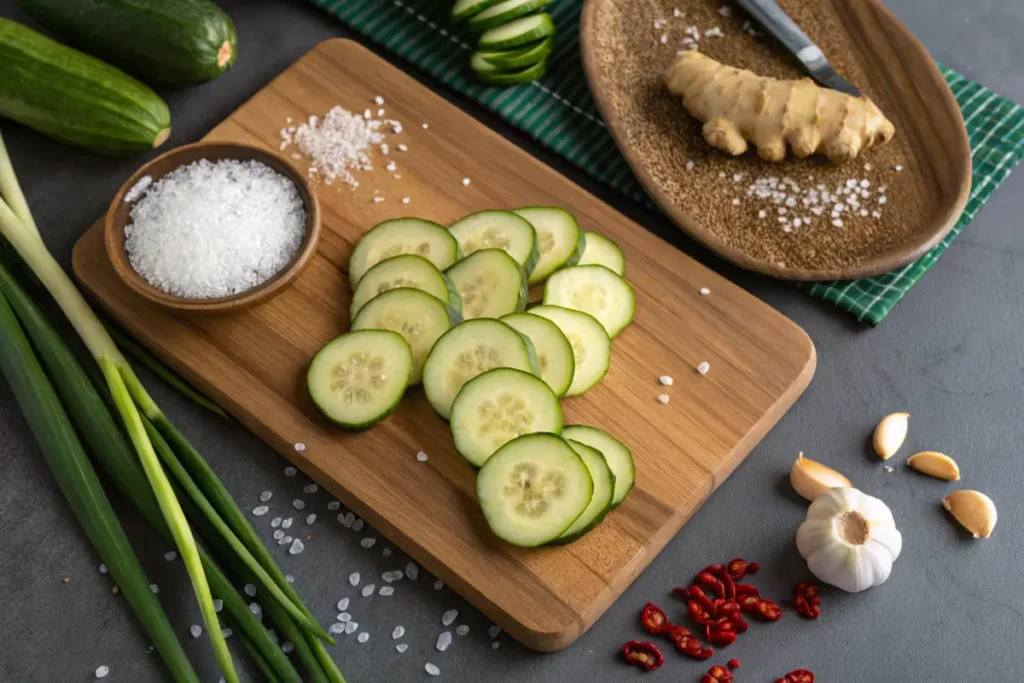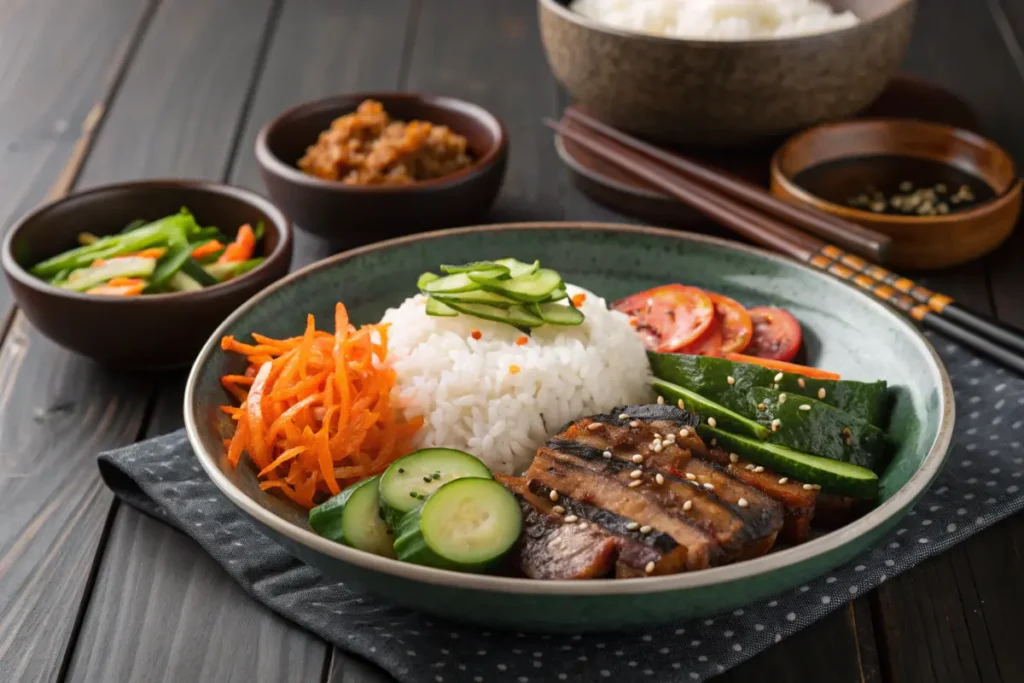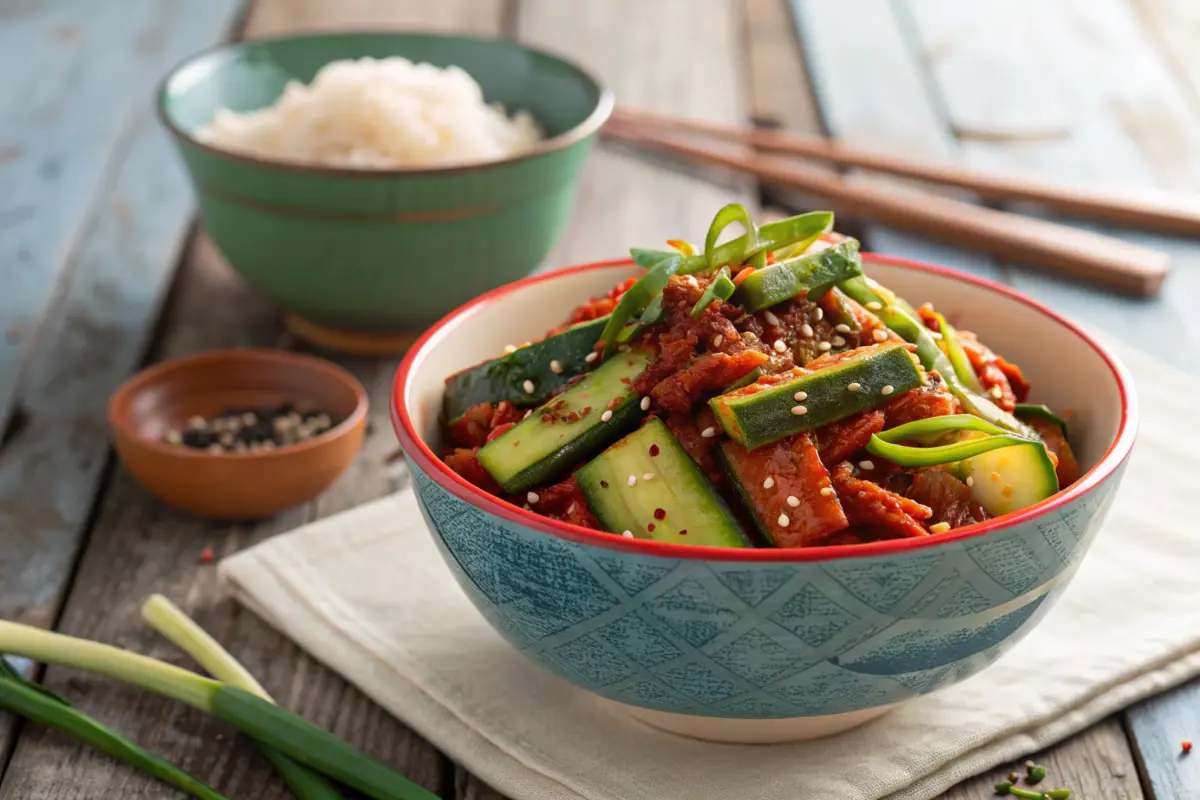Cucumber kimchi is a refreshing and spicy variation of traditional Korean kimchi. Packed with flavor, it’s perfect for those who want a quick, lighter, and crunchier alternative to cabbage kimchi. This guide takes you through everything you need to know, from its history and health benefits to step-by-step preparation methods. Whether you’re a seasoned kimchi maker or a curious beginner, this guide will help you create your own mouthwatering cucumber kimchi.
Introduction to Cucumber Kimchi
What is Cucumber Kimchi?
Cucumber kimchi, or oi kimchi in Korean, is a traditional side dish that combines the crisp texture of fresh cucumbers with the bold flavors of Korean spices. Unlike fermented cabbage kimchi, cucumber kimchi is typically enjoyed fresh or after a short fermentation, making it an ideal choice for those new to kimchi or looking for a quick pickling option.
Cultural Significance of Cucumber Kimchi
In Korean cuisine, kimchi is more than just a dish—it’s a cultural symbol. Cucumber kimchi represents the ingenuity of Korean cooking, adapting seasonal ingredients into versatile recipes. It’s especially popular during the summer months when cucumbers are abundant, providing a cool and refreshing contrast to hearty meals.
Health Benefits of Cucumber Kimchi
Rich in probiotics, vitamins, and antioxidants, cucumber kimchi is as nutritious as it is delicious. The fermentation process fosters gut-friendly bacteria that aid digestion and boost immunity. Plus, cucumbers are low in calories and high in hydration, making this dish a health-conscious choice. Add a sprinkle of gochugaru (Korean chili flakes), and you’ve got a dish that’s as spicy as it is wholesome!
Ingredients for Cucumber Kimchi
Essential Ingredients for Authentic Cucumber Kimchi
To make a flavorful cucumber kimchi recipe, you’ll need fresh and crisp cucumbers as the base. Persian or Kirby cucumbers work best due to their crunchy texture. Gochugaru (Korean chili flakes) is essential for authentic flavor, lending heat and color to the dish. Other key ingredients include garlic, ginger, fish sauce, and sugar for balanced taste. Don’t forget the scallions and sesame seeds for added aroma and visual appeal.
Optional Add-Ins for a Flavor Twist
While traditional recipes are straightforward, you can add extras to elevate your cucumber kimchi. Radish slices or carrots add a sweet crunch, while sesame oil gives a nutty depth. If you prefer vegan options, swap fish sauce with soy sauce or a vegan fish sauce substitute. Want to experiment further? Try incorporating herbs like cilantro for a fresh, zesty twist.
How to Select Fresh and Crisp Cucumbers
Choosing the right cucumbers is crucial for the perfect cucumber kimchi recipe. Look for firm cucumbers with a deep green hue and no soft spots. Avoid wax-coated ones, as they may hinder the absorption of spices. Organic cucumbers are ideal, as their skin retains maximum flavor. Wash and dry them thoroughly before use to ensure the spice paste clings well.
Traditional vs. Quick Cucumber Kimchi Recipes
Step-by-Step Traditional Cucumber Kimchi Recipe
The traditional cucumber kimchi recipe involves salting the cucumbers to draw out moisture, ensuring they absorb the flavorful spice mixture. Start by slicing the cucumbers lengthwise, leaving them attached at the base. Sprinkle salt generously, let them sit for 30 minutes, and rinse well. Prepare a spice paste by mixing gochugaru, minced garlic, ginger, fish sauce, and a pinch of sugar. Stuff the paste into the cucumbers, ensuring even coverage, and store them in a glass container to ferment.
Quick Cucumber Kimchi Recipe for Beginners
Pressed for time? Quick cucumber kimchi is your go-to. Slice cucumbers into thin rounds, toss them with salt, and let them sit for 10 minutes. Drain excess water, then mix them with the spice paste. This version skips lengthy fermentation, allowing you to enjoy a fresh, mildly spicy dish almost immediately.
Key Differences Between the Two Methods
While both methods yield tasty results, the traditional recipe involves fermentation, which develops complex flavors and probiotics. Quick cucumber kimchi, on the other hand, focuses on freshness and simplicity. If you’re new to kimchi-making or looking for a fast side dish, the quick version is perfect. However, if you seek deep, tangy flavors, the traditional method is worth the wait.
This comparison ensures you can choose the best cucumber kimchi recipe to suit your taste and schedule. For a deeper dive into the cultural significance of fermented foods, check resources like RecipeFoodies.
Step-by-Step Guide to Making Cucumber Kimchi
Preparation and Salting of Cucumbers

The foundation of a perfect cucumber kimchi recipe lies in the preparation of the cucumbers. Start by washing them thoroughly to remove any dirt or residue. Slice the cucumbers lengthwise, ensuring they remain attached at the base to hold the spice mixture. Sprinkle them generously with salt and let them sit for 30 minutes to an hour. This salting process draws out excess water, helping the cucumbers maintain their crunch during fermentation. Afterward, rinse the cucumbers under cold water to remove the salt, then pat them dry with a clean towel.
Creating the Spice Paste
The spice paste is the heart of any cucumber kimchi recipe. In a mixing bowl, combine gochugaru (Korean chili flakes), minced garlic, grated ginger, fish sauce (or soy sauce for a vegan option), and a pinch of sugar. Add a splash of water to create a spreadable consistency. For added depth of flavor, consider incorporating finely chopped scallions or julienned carrots. Taste the paste and adjust the seasoning as needed—it should be spicy, savory, and slightly sweet.
Mixing and Storing for Fermentation
Carefully stuff the spice paste into the cucumber slits, ensuring an even coating. If you’re using cucumber slices, toss them in the spice mixture until they’re well coated. Place the seasoned cucumbers in a sterilized glass container, pressing them down to remove air pockets. Seal the container tightly and leave it at room temperature for 1-2 days to ferment. Afterward, transfer the kimchi to the refrigerator, where it will continue to develop its tangy flavor.
Common Mistakes and How to Avoid Them
Mistakes happen, but they’re easy to fix! If your cucumbers become too salty, rinse them thoroughly before seasoning. Avoid overpacking your container, as it may prevent proper fermentation. Lastly, always use clean utensils to prevent contamination and ensure your cucumber kimchi recipe stays fresh and delicious.
Serving Suggestions and Pairings
Best Dishes to Serve with Cucumber Kimchi

Cucumber kimchi is a versatile side dish that complements a variety of meals. Its crisp texture and bold flavors pair beautifully with grilled meats like Korean bulgogi or spicy pork ribs. For a lighter option, serve it alongside steamed rice and miso soup to balance the heat and tanginess. If you’re hosting a Korean-inspired dinner, include cucumber kimchi as part of a vibrant banchan spread.
Creative Ways to Use Leftover Kimchi
If you find yourself with extra cucumber kimchi, there are plenty of creative ways to enjoy it. Add it to sandwiches or wraps for a spicy kick. Toss it into salads for an unexpected crunch, or chop it finely and mix it into fried rice for a quick, flavorful meal. For a refreshing summer treat, use cucumber kimchi as a topping for cold noodles or chilled soba dishes.
Bonus Tip: For more innovative recipes, explore RecipeFoodies, where you’ll find ideas to make the most of your leftover dishes. Whether it’s side dishes or main courses, there’s plenty to inspire your culinary creativity!
Storage Tips and Shelf Life of Cucumber Kimchi
Proper Storage Techniques
To keep your cucumber kimchi recipe fresh and flavorful, proper storage is essential. After the initial fermentation at room temperature, transfer the kimchi to an airtight glass or plastic container. Make sure the cucumbers are fully submerged in the spice mixture to prevent them from drying out. Store the container in the refrigerator, where the cool environment will slow fermentation and help preserve the texture.
Always use clean utensils when scooping out servings to avoid introducing bacteria. Keep the lid tightly sealed to prevent exposure to air, which can lead to spoilage. By following these steps, your cucumber kimchi will remain crisp and delicious for weeks.
How Long Does Cucumber Kimchi Last?
While traditional kimchi can ferment for months, cucumber kimchi is best enjoyed fresh or within a shorter time frame. It typically lasts 2-3 weeks in the refrigerator, depending on how tangy you like it. Over time, the cucumbers may soften, and the flavors will become more pronounced. If you prefer a milder taste, consume it within the first week. For longer-lasting kimchi, consider using thicker cucumbers or adjusting the salt content during preparation.
FAQs About Cucumber Kimchi
Can I Use Other Types of Cucumbers?
Yes! While Korean recipes often recommend Kirby or Persian cucumbers for their crunch, you can experiment with English cucumbers or mini cucumbers. If using larger varieties, slice them thinner to ensure they absorb the seasoning. Keep in mind that thicker cucumbers may require more time to salt and marinate.
What Are Some Common Substitutes for Gochugaru?
Gochugaru is a staple in most cucumber kimchi recipes, but there are alternatives if you can’t find it. Crushed red pepper flakes, smoked paprika, or cayenne can mimic the heat, though they may lack the smoky depth of gochugaru. If you want a milder flavor, use a mix of sweet paprika and red pepper.
Is Cucumber Kimchi Vegan-Friendly?
Absolutely! To make a vegan version of this cucumber kimchi recipe, replace fish sauce with soy sauce or a vegan fish sauce substitute. You’ll still get the umami flavor without compromising on dietary preferences.
How to Fix Overly Salty Kimchi?
If your cucumber kimchi turns out too salty, don’t panic! Rinse the cucumbers in cold water before mixing them with the spice paste. Another trick is to add a small amount of sugar or julienned carrots to balance the flavor. For extreme cases, mix the salty kimchi with plain steamed rice to dilute the saltiness.
For more tips on mastering traditional and modern recipes, visit culinary sites like RecipeFoodies, where inspiration for creative dishes awaits! Whether you’re a beginner or a seasoned cook, there’s always something new to learn.
Nutritional Benefits of Cucumber Kimchi
Why Cucumber Kimchi is a Healthy Choice
A cucumber kimchi recipe is not only flavorful but also packed with nutrition. Cucumbers are low in calories and rich in hydration, making them perfect for a light side dish. They contain essential vitamins like vitamin K, which supports bone health, and antioxidants that help fight free radicals. The fermentation process adds probiotics, which promote gut health and aid digestion.
Cucumber kimchi is also a great source of fiber, supporting overall digestive wellness. The garlic and ginger in the spice paste bring anti-inflammatory properties, while gochugaru contributes capsaicin, which may boost metabolism. Together, these ingredients create a dish that’s as nourishing as it is delicious.
Adapting for Dietary Preferences
One of the great things about a cucumber kimchi recipe is its adaptability. It can be made vegan, gluten-free, or low-sodium to suit various dietary needs. Simply swap fish sauce for a plant-based alternative and reduce the salt during preparation. This versatility ensures everyone can enjoy its health benefits without compromise.
Why Cucumber Kimchi is a Must-Try Dish
A Dish for All Seasons
A cucumber kimchi recipe shines year-round, but it’s particularly refreshing during the summer. The crisp cucumbers and bold spices offer a cooling contrast to hot days, while the tangy flavor pairs well with hearty winter meals. Its versatility means you can enjoy it as a snack, side, or even a topping for fusion dishes like tacos or burgers.
Easy to Make, Hard to Forget
Unlike traditional kimchi, which requires longer fermentation, cucumber kimchi is beginner-friendly and quick to prepare. Its short fermentation time makes it an ideal entry point for those new to Korean cuisine. The vibrant colors and irresistible flavors make it a showstopper at any table, whether you’re hosting a dinner party or enjoying a quiet meal at home.
Whether you’re exploring Korean food for the first time or looking to add variety to your meals, cucumber kimchi is a must-try. For more innovative recipes and cooking tips, visit websites like RecipeFoodies, where culinary inspiration awaits.
Conclusion: The Perfect Blend of Flavor and Simplicity
Cucumber kimchi is more than just a dish—it’s a delightful fusion of bold flavors, vibrant colors, and health benefits. This cucumber kimchi recipe offers a refreshing twist on traditional kimchi, making it perfect for those who crave a lighter, crunchier option. Whether you’re new to Korean cuisine or a seasoned kimchi enthusiast, its quick preparation and adaptability make it a must-have in your culinary repertoire.
From selecting the freshest cucumbers to experimenting with spices and pairings, every step is an opportunity to create a dish that’s uniquely yours. Its versatility ensures it can complement any meal, while its nutritional benefits make it a guilt-free indulgence. Ready in just a few hours, this recipe proves that creating authentic flavors doesn’t have to be complicated.
So why not give it a try? Whether you’re savoring it fresh or fermented, cucumber kimchi promises to add a spicy, tangy kick to your table. For more inspiration, be sure to explore resources like RecipeFoodies to discover a world of recipes that excite your taste buds and spark your creativity. Happy kimchi-making!

